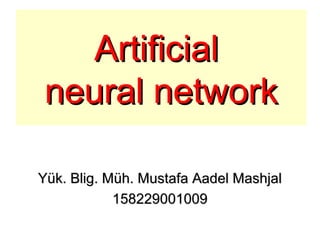Neural networks can be biological models of the brain or artificial models created through software and hardware. The human brain consists of interconnected neurons that transmit signals through connections called synapses. Artificial neural networks aim to mimic this structure using simple processing units called nodes that are connected by weighted links. A feed-forward neural network passes information in one direction from input to output nodes through hidden layers. Backpropagation is a common supervised learning method that uses gradient descent to minimize error by calculating error terms and adjusting weights between layers in the network backwards from output to input. Neural networks have been applied successfully to problems like speech recognition, character recognition, and autonomous vehicle navigation.












































![Ways of learning with an ANN
• Add nodes & connections
• Subtract nodes & connections
• Modify connection weights
– current focus
– can simulate first two
• I/O pairs:
– given the inputs, what should the output be?
[“typical” learning problem]](https://image.slidesharecdn.com/artificialneuralnetwork-170311194336/85/Artificial-neural-network-45-320.jpg)









